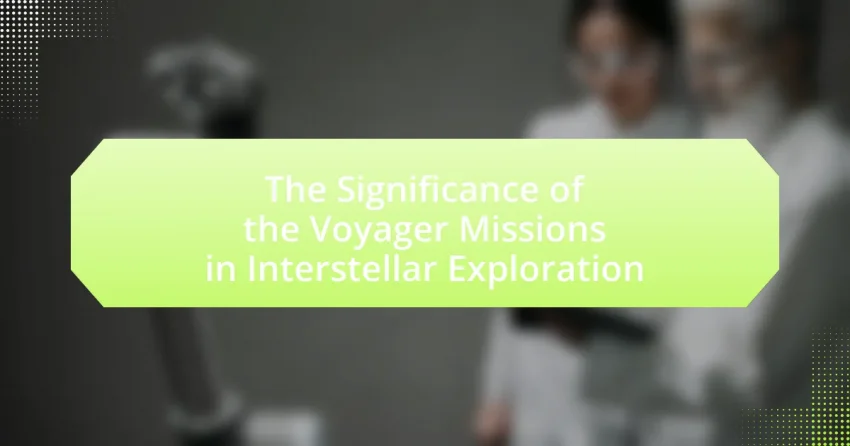The Voyager Missions, comprising Voyager 1 and Voyager 2, are NASA’s groundbreaking space probes launched in 1977 to explore the outer planets and interstellar space. Their primary objectives included studying Jupiter, Saturn, Uranus, and Neptune, along with their moons and rings, to gather critical data on planetary atmospheres, magnetic fields, and the potential for life. The missions have yielded significant discoveries, such as the first detailed images of these planets and insights into the heliosphere, marking Voyager 1 as the first human-made object to enter interstellar space in 2012. The ongoing contributions of the Voyager spacecraft continue to enhance our understanding of cosmic phenomena and inform future interstellar exploration efforts.

What are the Voyager Missions and their Objectives?
The Voyager Missions are a pair of space probes, Voyager 1 and Voyager 2, launched by NASA in 1977 to explore the outer planets of the solar system and beyond. Their primary objectives include conducting detailed studies of Jupiter, Saturn, Uranus, and Neptune, as well as their moons and rings, to gather data on their atmospheres, magnetic fields, and potential for supporting life. Voyager 1 has since entered interstellar space, continuing to send back valuable information about the heliosphere and cosmic rays, while Voyager 2 has followed suit, providing insights into the outer solar system and the interstellar medium. The missions have significantly advanced our understanding of planetary science and the boundaries of our solar system, with Voyager 1 being the first human-made object to reach interstellar space, a milestone achieved in 2012.
How did the Voyager Missions begin?
The Voyager Missions began with NASA’s decision in 1972 to launch two spacecraft, Voyager 1 and Voyager 2, to explore the outer planets of the solar system. This initiative was part of a larger plan to take advantage of a rare planetary alignment that allowed for a gravitational assist trajectory, enabling the spacecraft to visit Jupiter, Saturn, Uranus, and Neptune. The missions were designed to gather data about these planets and their moons, significantly enhancing our understanding of the solar system.
What were the key milestones in the development of the Voyager spacecraft?
The key milestones in the development of the Voyager spacecraft include the initial concept phase in the early 1970s, the launch of Voyager 1 and Voyager 2 on September 5 and August 20, 1977, respectively, and their successful flybys of the outer planets. The spacecraft were designed to take advantage of a rare planetary alignment that allowed them to visit Jupiter, Saturn, Uranus, and Neptune. Voyager 1’s flyby of Jupiter occurred in March 1979, followed by Saturn in November 1980, while Voyager 2 flew by Jupiter in July 1979, Saturn in August 1981, Uranus in January 1986, and Neptune in August 1989. These missions provided unprecedented data about the planets and their moons, significantly advancing our understanding of the solar system. The Voyager spacecraft also became the first human-made objects to enter interstellar space, with Voyager 1 crossing the heliopause in August 2012 and Voyager 2 following in November 2018.
What scientific goals were set for the Voyager Missions?
The scientific goals set for the Voyager Missions included the exploration of the outer planets, the study of their atmospheres, magnetic fields, and moons, as well as the investigation of the heliosphere and interstellar space. Specifically, Voyager 1 and Voyager 2 aimed to gather data on Jupiter, Saturn, Uranus, and Neptune, providing unprecedented insights into their compositions and dynamics. The missions also sought to measure cosmic rays, solar wind, and magnetic fields beyond the solar system, contributing to our understanding of the solar system’s boundary and the nature of interstellar space. These objectives were validated by the successful flybys and data collection from the planets, which have significantly advanced planetary science and astrophysics.
What discoveries have the Voyager Missions made?
The Voyager Missions have made significant discoveries, including the first detailed images of Jupiter and Saturn, revealing their complex atmospheres and ring systems. Voyager 1 discovered active volcanoes on Jupiter’s moon Io and the intricate structure of Saturn’s rings, while Voyager 2 provided the first close-up images of Uranus and Neptune, uncovering their unique features such as Uranus’s tilted axis and Neptune’s Great Dark Spot. Additionally, both spacecraft contributed to our understanding of the heliosphere and the interstellar medium, with Voyager 1 becoming the first human-made object to enter interstellar space in 2012, providing invaluable data about cosmic rays and magnetic fields beyond our solar system.
How did Voyager 1 and 2 contribute to our understanding of the outer planets?
Voyager 1 and 2 significantly enhanced our understanding of the outer planets by providing unprecedented data and images during their flybys. Voyager 1, which flew past Jupiter in 1979 and Saturn in 1980, revealed detailed information about their atmospheres, magnetic fields, and moons, including the discovery of active volcanism on Io and the intricate ring system of Saturn. Voyager 2 followed with flybys of Jupiter, Saturn, Uranus, and Neptune between 1979 and 1989, offering insights into the atmospheres and weather patterns of these planets, as well as the discovery of new moons and rings around Uranus and Neptune. The missions collectively provided critical data that reshaped our understanding of planetary formation and dynamics in the outer solar system, establishing a foundation for future exploration and study.
What were the significant findings regarding the heliosphere from the Voyager Missions?
The significant findings regarding the heliosphere from the Voyager Missions include the discovery of the heliopause, which is the boundary where the solar wind from the Sun meets the interstellar medium. Voyager 1, which crossed this boundary in 2012, provided data indicating that the heliosphere is not a uniform bubble but has a complex structure influenced by interstellar magnetic fields and cosmic rays. Additionally, Voyager 2’s data, obtained in 2018, revealed variations in the density and temperature of the solar wind as it interacts with the surrounding interstellar environment. These findings have enhanced the understanding of the heliosphere’s role in protecting the solar system from cosmic radiation and have implications for future interstellar exploration.
Why are the Voyager Missions significant for interstellar exploration?
The Voyager Missions are significant for interstellar exploration because they are the first human-made objects to enter interstellar space, providing invaluable data about the heliosphere and the boundary between solar and interstellar environments. Launched in 1977, Voyager 1 and Voyager 2 have traveled beyond the influence of the Sun, with Voyager 1 entering interstellar space in 2012 and Voyager 2 following in 2018. These missions have delivered critical information about cosmic rays, magnetic fields, and the interstellar medium, enhancing our understanding of the universe beyond our solar system. Their longevity and the data collected have established a foundation for future interstellar missions, demonstrating the feasibility of long-duration space exploration.
How do the Voyager Missions enhance our knowledge of interstellar space?
The Voyager Missions enhance our knowledge of interstellar space by providing direct measurements and data from beyond the heliosphere, the region dominated by the solar wind. Voyager 1 and Voyager 2, launched in 1977, have traveled further than any human-made objects, allowing them to collect vital information about the interstellar medium, cosmic rays, and magnetic fields. For instance, Voyager 1 entered interstellar space in 2012 and has since revealed that the density of interstellar plasma is significantly higher than previously estimated, which helps refine models of the solar system’s boundary with interstellar space. Additionally, the missions have detected variations in cosmic ray intensity, contributing to our understanding of the interactions between solar and interstellar particles.
What role do the Voyager Missions play in the search for extraterrestrial life?
The Voyager Missions play a crucial role in the search for extraterrestrial life by providing valuable data about the outer planets and their moons, which may harbor conditions suitable for life. Launched in 1977, Voyager 1 and Voyager 2 have conducted flybys of Jupiter, Saturn, Uranus, and Neptune, revealing diverse environments and geological activity. For instance, the discovery of subsurface oceans on moons like Europa and Enceladus suggests potential habitats for microbial life. Additionally, the missions have contributed to our understanding of the heliosphere and interstellar space, informing the search for biosignatures beyond our solar system. The data collected by the Voyagers continues to guide astrobiological research and the design of future missions aimed at exploring potentially habitable worlds.

How have the Voyager Missions influenced future space exploration?
The Voyager Missions have significantly influenced future space exploration by providing invaluable data about the outer planets and interstellar space, which has shaped subsequent mission designs and scientific objectives. The missions, launched in 1977, successfully conducted flybys of Jupiter, Saturn, Uranus, and Neptune, revealing critical information about their atmospheres, moons, and ring systems. This data has informed the planning of missions like the Juno spacecraft to Jupiter and the upcoming Europa Clipper mission, which aims to explore the icy moon Europa for signs of life. Furthermore, Voyager’s entry into interstellar space has provided insights into the heliosphere and cosmic rays, guiding future missions such as the Interstellar Probe, which aims to explore the boundaries of the solar system. The technological advancements and scientific methodologies developed during the Voyager Missions have set a precedent for deep space exploration, emphasizing the importance of long-duration missions and autonomous spacecraft operations.
What technological advancements resulted from the Voyager Missions?
The Voyager Missions resulted in significant technological advancements, including the development of miniaturized spacecraft systems, advanced communication technologies, and improved data processing capabilities. The missions utilized a unique power source, the radioisotope thermoelectric generator, which allowed for long-duration space exploration without reliance on solar power. Additionally, the spacecraft’s communication system employed the use of the Deep Space Network, enhancing the ability to transmit data over vast distances. These advancements have influenced subsequent space missions and contributed to the evolution of satellite technology and interplanetary exploration.
How have the instruments used in the Voyager Missions shaped future spacecraft design?
The instruments used in the Voyager Missions have significantly influenced future spacecraft design by establishing benchmarks for scientific instrumentation and engineering resilience in extreme environments. The Voyager spacecraft were equipped with advanced instruments such as the Plasma Science Experiment, the Imaging Science System, and the Cosmic Ray System, which provided critical data about the outer planets and interstellar space. These instruments demonstrated the importance of multi-functional capabilities and robustness, leading to the incorporation of similar technologies in subsequent missions like the Mars rovers and the Juno spacecraft. For instance, the success of the Voyager’s imaging systems has inspired the design of high-resolution cameras in newer missions, ensuring that they can capture detailed data in harsh conditions. Additionally, the engineering lessons learned from the Voyager’s long-duration power systems, such as radioisotope thermoelectric generators, have been applied to enhance the longevity and reliability of future spacecraft.
What lessons were learned from the Voyager Missions that apply to upcoming missions?
The Voyager Missions taught critical lessons about long-duration space exploration that are applicable to future missions. One key lesson is the importance of robust engineering and redundancy; Voyager spacecraft were designed with multiple systems to ensure functionality despite potential failures, which is essential for missions that may last decades. Additionally, the missions highlighted the value of interdisciplinary collaboration, as scientists from various fields worked together to analyze data and make discoveries, a practice that should be emulated in future projects. The Voyager Missions also demonstrated the necessity of planning for communication delays, as signals from Voyager take over 20 hours to reach Earth, emphasizing the need for autonomous systems in distant missions. These lessons are foundational for the design and execution of upcoming interstellar exploration initiatives.
How do the Voyager Missions inspire public interest in space exploration?
The Voyager Missions inspire public interest in space exploration by showcasing humanity’s capability to explore distant worlds and communicate across vast distances. Launched in 1977, Voyager 1 and Voyager 2 provided groundbreaking images and data from the outer planets, including Jupiter and Saturn, which captivated the public’s imagination. The missions’ iconic “Pale Blue Dot” photograph, taken by Voyager 1 from over 3 billion miles away, highlighted Earth’s fragility and unity, prompting widespread reflection on our place in the universe. Additionally, the missions’ ongoing journey into interstellar space continues to engage audiences, as they represent the farthest human-made objects from Earth, symbolizing the relentless pursuit of knowledge and exploration.
What impact have the Voyager Missions had on popular culture and education?
The Voyager Missions have significantly influenced popular culture and education by inspiring a sense of wonder about space exploration and advancing scientific literacy. The missions, launched in 1977, provided iconic images and data about the outer planets, which have been referenced in various films, books, and television shows, such as “Star Trek” and “The Simpsons.” Additionally, the Golden Record, included on the Voyager spacecraft, serves as a cultural artifact that represents humanity’s voice and music, further embedding the missions in cultural consciousness. In education, the Voyager Missions have become a key subject in science curricula, illustrating principles of physics, astronomy, and engineering, while also promoting STEM engagement among students. The missions’ achievements are often highlighted in documentaries and educational programs, reinforcing their role as a catalyst for interest in space science and exploration.
How can the legacy of the Voyager Missions motivate future generations of scientists?
The legacy of the Voyager Missions can motivate future generations of scientists by exemplifying the spirit of exploration and the pursuit of knowledge beyond our planet. The Voyager spacecraft, launched in 1977, provided groundbreaking data about the outer planets and their moons, significantly expanding our understanding of the solar system. For instance, Voyager 1’s flyby of Jupiter revealed its complex atmosphere and numerous moons, while Voyager 2’s encounters with Uranus and Neptune offered unprecedented insights into these distant worlds. This pioneering work not only set a precedent for future missions but also inspired a sense of curiosity and ambition in young scientists, demonstrating that ambitious projects can yield transformative discoveries. The ongoing journey of the Voyager spacecraft, now in interstellar space, serves as a powerful reminder of the importance of scientific inquiry and the potential for human ingenuity to explore the unknown.

What are the current and future implications of the Voyager Missions?
The current implications of the Voyager Missions include the ongoing collection of data about the interstellar medium, which enhances our understanding of cosmic phenomena. Voyager 1 and Voyager 2, launched in 1977, have provided invaluable insights into the heliosphere and the boundaries of our solar system, with Voyager 1 entering interstellar space in 2012 and Voyager 2 following in 2018. These missions continue to send back data that informs scientific research on solar winds, cosmic rays, and magnetic fields, contributing to the field of astrophysics.
Future implications of the Voyager Missions involve the potential for long-term data collection that could inform future interstellar exploration and the search for extraterrestrial life. As the spacecraft travel further from Earth, they may encounter new cosmic phenomena that could reshape our understanding of the universe. The missions also serve as a technological benchmark for future missions, demonstrating the feasibility of long-duration space exploration. The Golden Record carried by both spacecraft, which contains sounds and images representing life on Earth, may one day be discovered by extraterrestrial civilizations, fostering a connection between humanity and potential alien life forms.
How are the Voyager spacecraft still contributing to science today?
The Voyager spacecraft are still contributing to science today by providing valuable data about the interstellar medium and cosmic rays. Since their launch in 1977, Voyager 1 and Voyager 2 have traveled beyond the heliosphere, allowing scientists to study the characteristics of the space environment outside our solar system. For instance, Voyager 1 entered interstellar space in 2012, and its instruments have measured the density and temperature of interstellar plasma, revealing insights into the nature of the local interstellar medium. Additionally, both spacecraft continue to send back data on cosmic rays, helping researchers understand the sources and behavior of high-energy particles in space. This ongoing data collection is crucial for advancing our knowledge of astrophysics and the dynamics of the universe.
What ongoing research is being conducted using data from the Voyager Missions?
Ongoing research using data from the Voyager Missions focuses on understanding the heliosphere, the boundary of the solar system, and the interstellar medium. Scientists analyze data from Voyager 1 and Voyager 2 to study cosmic rays, magnetic fields, and plasma waves, which provide insights into the environment beyond our solar system. For instance, a study published in the journal “Nature Astronomy” by researchers from NASA’s Jet Propulsion Laboratory examines the interaction between solar wind and interstellar space, revealing new information about the structure of the heliosphere. This research is crucial for comprehending the dynamics of our solar system’s influence on interstellar space and the broader cosmic environment.
How do the Voyager Missions inform our understanding of cosmic phenomena?
The Voyager Missions enhance our understanding of cosmic phenomena by providing direct measurements and data from the outer planets and interstellar space. Voyager 1 and Voyager 2, launched in 1977, have transmitted invaluable information about the atmospheres, magnetic fields, and radiation environments of Jupiter, Saturn, Uranus, and Neptune. For instance, Voyager 1’s crossing of the heliopause in 2012 marked humanity’s first entry into interstellar space, revealing insights into the solar wind’s interaction with the interstellar medium. Additionally, the missions have detected cosmic rays and provided data on the structure of the heliosphere, contributing to our knowledge of cosmic radiation and its effects on space weather. These findings have been crucial for advancing astrophysical theories and understanding the dynamics of our solar system and beyond.
What practical insights can we gain from the Voyager Missions?
The Voyager Missions provide practical insights into the nature of interstellar space, planetary science, and the longevity of spacecraft technology. These missions have revealed critical information about the outer planets, including detailed data on Jupiter’s atmosphere and Saturn’s rings, which have enhanced our understanding of planetary formation and dynamics. Additionally, Voyager’s journey has demonstrated the effectiveness of nuclear power systems for long-duration missions, as evidenced by its use of radioisotope thermoelectric generators, allowing it to operate far from the Sun. The missions also serve as a testament to human ingenuity and the potential for future exploration, as they continue to send data back from beyond the heliosphere, illustrating the challenges and possibilities of interstellar communication and navigation.
How can the methodologies used in the Voyager Missions be applied to new space missions?
The methodologies used in the Voyager Missions can be applied to new space missions by leveraging their successful strategies in long-duration space travel, data collection, and autonomous operation. The Voyager Missions utilized gravity assists to conserve fuel and increase speed, a technique that can be replicated in future missions to optimize trajectory and resource management. Additionally, the robust engineering and design principles that allowed Voyager spacecraft to operate in extreme environments for decades can inform the development of new spacecraft, ensuring reliability and longevity. The extensive data collection methods, including remote sensing and in-situ measurements, provide a framework for gathering scientific information from distant celestial bodies, which can enhance the scientific return of future missions. The Voyager Missions also demonstrated the importance of international collaboration and public engagement, which can be vital for the success and funding of new space initiatives.
What best practices can be derived from the operational history of the Voyager Missions?
The operational history of the Voyager Missions reveals several best practices for interstellar exploration, including robust engineering design, long-term planning, and effective communication strategies. The Voyager spacecraft were designed with redundancy in critical systems, allowing them to continue functioning despite component failures; for instance, Voyager 1 and 2 have operated for over 45 years, far exceeding their initial mission lifespan of five years. Additionally, the missions emphasized the importance of thorough mission planning, as evidenced by the precise trajectory calculations that enabled the gravitational assists from multiple planets, optimizing fuel efficiency and extending mission duration. Effective communication was also crucial, demonstrated by the use of the Deep Space Network, which maintained contact with the spacecraft over vast distances, ensuring data transmission and operational commands were successfully executed. These practices collectively underscore the importance of resilience, foresight, and adaptability in the field of interstellar exploration.
